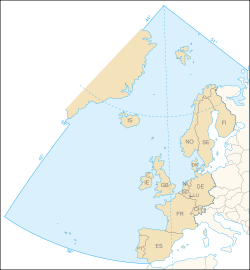OSPAR Convention

| Part of a series on |
| Pollution |
|---|
 |
The Convention for the Protection of the Marine Environment of the North-East Atlantic[1] or OSPAR Convention is the current legislative instrument regulating international cooperation on environmental protection in the North-East Atlantic. Work carried out under the convention is managed by the OSPAR Commission, which is made up of representatives of the Governments of the 15 signatory nations, and representatives of the European Commission, representing the European Union.[1]
The OSPAR Convention was concluded at

History
The Convention for the Protection of the Marine Environment of the North-East Atlantic was opened for signature at the

The first Ministerial Meeting of the OSPAR Commission at Sintra, Portugal, in 1998 adopted Annex V to the Convention, extending the cooperation of the signatory parties to cover "all human activities that might adversely affect the marine environment of the North East Atlantic".[1] Nevertheless, programmes and measures cannot be adopted under the Convention on questions relating to fisheries management, which are currently coordinated by European nations in the north east Atlantic and North Sea by the International Council for the Exploration of the Sea (ICES). The OSPAR convention now regulates European standards on marine biodiversity, eutrophication, the release of hazardous and radioactive substances into the seas, the offshore oil and gas industry and baseline monitoring of environmental conditions.[1]
In 2000, the OSPAR Commission published a comprehensive report on the quality of the marine environment of the North-East Atlantic. This was supported by five smaller reports on the different parts of the OSPAR maritime area –the Arctic, the Greater North Sea, the Celtic Seas, the Bay of Biscay/Golfe de Gascogne and Iberian waters, and the Wider Atlantic.[1]
According to the fr :Association pour le contrôle de la radioactivité dans l'Ouest, if tritium and iodine 129 discharges from the La Hague site into the Alderney Race do not diminish significantly, it will be difficult to achieve the objective of zero radioelement concentrations in the North Atlantic by 2020.[5]
In June 2007, OSPAR signatory parties agreed to amend the Convention in order to make mandatory the application of the treaty in the case of geological storage of
See also
- Convention for the Prevention of Marine Pollution by Dumping from Ships and Aircraft
References
- ^ a b c d e f g h "Convention Text". OSPAR Commission. Retrieved 7 February 2022.
- ^ a b About OSPAR
- ^ River Rhine.[2]
- ^ "Discharges of radioactive elements" (PDF). acro.eu.org. 22 April 2013.
- OCLC 4934390933.

